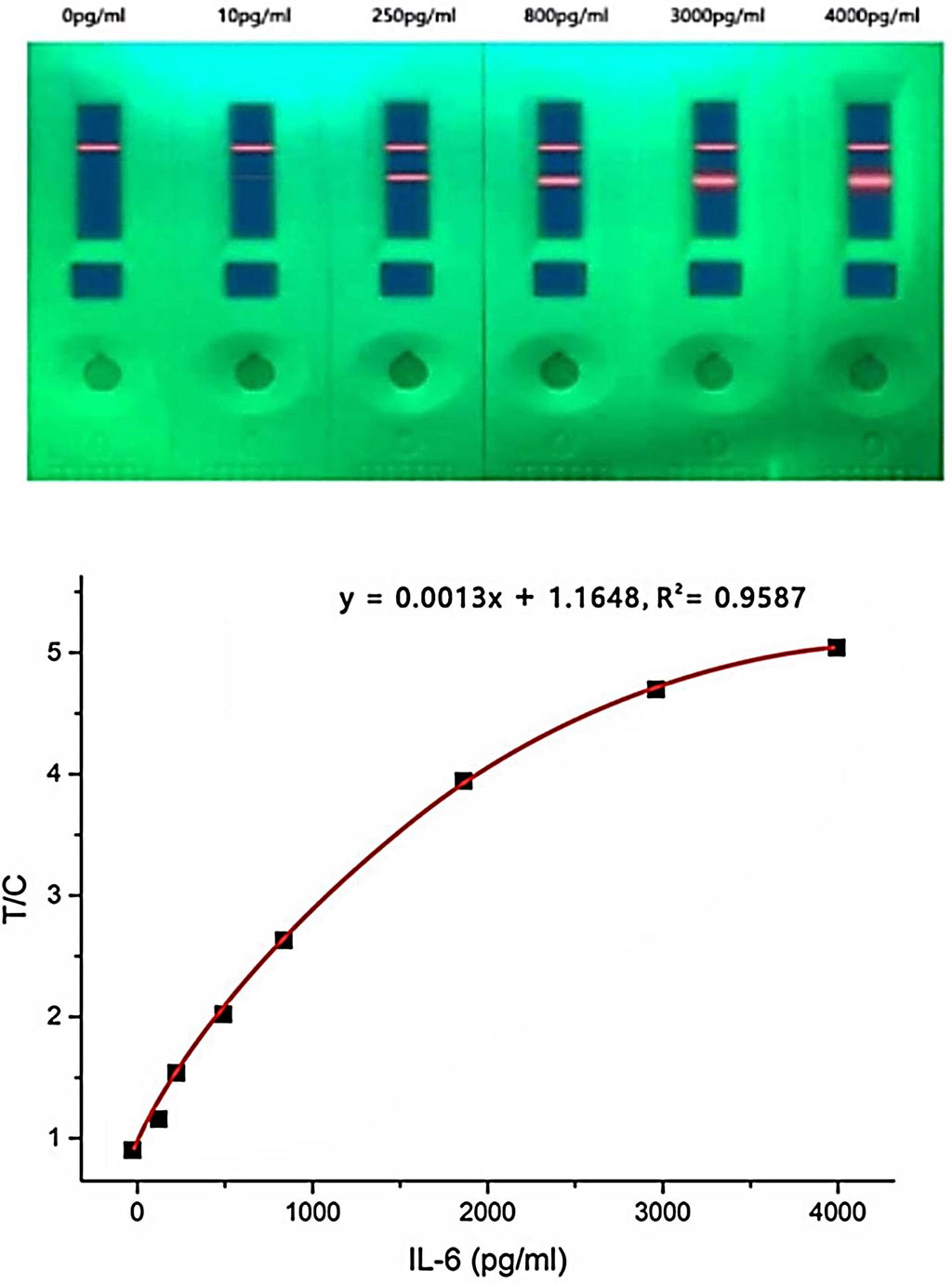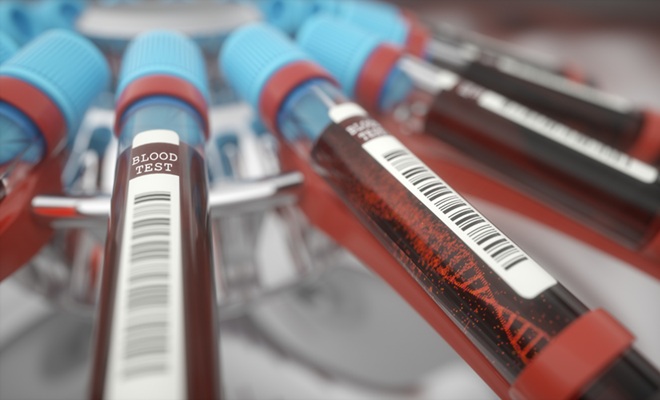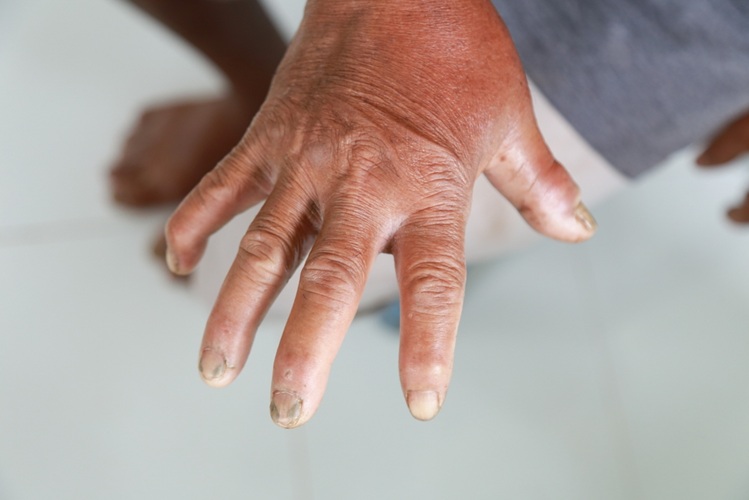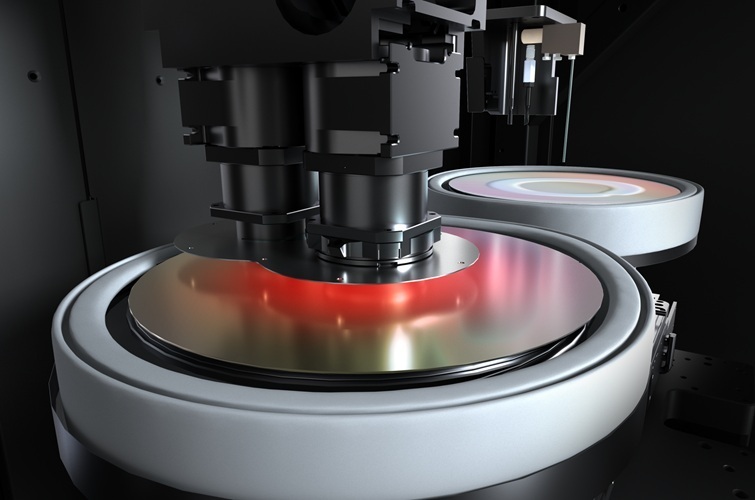Immunoassay Developed for Quantitative Detection of Serum Interleukin‐6
|
By LabMedica International staff writers Posted on 07 Apr 2021 |

Image: The quantum dot (QD)‐based fluorescence lateral flow immunoassay (LFIA) strip can rapidly and accurately detect IL‐6 levels at different concentrations (Photo courtesy of University of South China)
Interleukin‐6 (IL‐6) is a multifunctional protein and is primarily produced by macrophages, monocytes, fibroblasts, and T lymphocytes, and plays important roles in immune regulation, hematopoiesis, inflammation, and tumorigenesis.
IL‐6 has shown the highest value in the diagnosis of sepsis compared with procalcitonin (PCT) and C‐reactive protein (CRP), which are also important biomarkers of infection. Traditional IL‐6 detection methods include chemiluminescence immunoassays (CLIA), enzyme‐linked immunosorbent assays (ELISA) and electrochemiluminescence immunoassays (ECLIA).
Medical Scientists at the Second Affiliated Hospital of University of South China (Hengyang, China) developed a quantum dot (QD)‐based fluorescence lateral flow immunoassay (LFIA) strip that can rapidly and accurately detect IL‐6 levels. The QD‐based LFIA strips were fabricated by conjugating cadmium selenide/zinc sulfide (CdSe/ZnS) QDs to the IL‐6 antibody. The strips were made of nitrocellulose (NC) membranes, semi‐rigid polyvinylchloride (PVC) sheets, and polyester fiber. The IL‐6 CLIA kits were from Beckman Coulter (Pasadena, CA, USA).
The fluorescence intensity of the test (T) line and the control (C) line on the strip were detected using the self‐designed KF‐Q001‐A fluorescence immunoassay analyzer (Kingfocus Biomedical Engineering Co., Ltd, Shenzhen City, China). The QDs and antibodies were dispensed onto the strip using a piece of three‐dimensional gold‐spraying equipment. IL‐6 CLIA detection was performed on the Beckman Coulter Dxl800 instrument. A total of 200 human serum samples were obtained from a local hospital, The IL‐6 concentrations of these samples ranged from 0 to 580.42 ng/mL. The samples were detected using the strip and the Beckman IL‐6 CLIA kit within two hours of each other.
The investigators reported that the test strip's linear range was 10–4,000 pg/mL, with a linear correlation coefficient of R2 ≥ 0.959. The sensitivity of the test strip was 1.995 pg/mL. The recovery rate was 95.72%–102.63%, indicating satisfying accuracy. The coefficient of variation (CV) of the intra‐assay was 2.148%–3.903%, while the inter‐assay was 2.412%–5.293%, verifying the strip's high precision. The cross‐reaction rates with various interleukins (IL‐1α, IL‐1β, IL‐2, IL‐4, and IL‐8) and interferon‐γ (IFN‐γ) were all less than 0.1%.
The authors concluded that they had successfully established a QD‐based LFIA method for rapid and accurate detection of human serum IL‐6, providing a more simple, robust, and economic point-of-care technology (POCT) for IL‐6 quantification, which is of great value for the early detection and treatment of sepsis and related disorders. The study was published on March 24, 2021 in the Journal of Clinical Laboratory Analysis.
Related Links:
Second Affiliated Hospital of University of South China
Beckman Coulter
Kingfocus Biomedical Engineering Co., Ltd
IL‐6 has shown the highest value in the diagnosis of sepsis compared with procalcitonin (PCT) and C‐reactive protein (CRP), which are also important biomarkers of infection. Traditional IL‐6 detection methods include chemiluminescence immunoassays (CLIA), enzyme‐linked immunosorbent assays (ELISA) and electrochemiluminescence immunoassays (ECLIA).
Medical Scientists at the Second Affiliated Hospital of University of South China (Hengyang, China) developed a quantum dot (QD)‐based fluorescence lateral flow immunoassay (LFIA) strip that can rapidly and accurately detect IL‐6 levels. The QD‐based LFIA strips were fabricated by conjugating cadmium selenide/zinc sulfide (CdSe/ZnS) QDs to the IL‐6 antibody. The strips were made of nitrocellulose (NC) membranes, semi‐rigid polyvinylchloride (PVC) sheets, and polyester fiber. The IL‐6 CLIA kits were from Beckman Coulter (Pasadena, CA, USA).
The fluorescence intensity of the test (T) line and the control (C) line on the strip were detected using the self‐designed KF‐Q001‐A fluorescence immunoassay analyzer (Kingfocus Biomedical Engineering Co., Ltd, Shenzhen City, China). The QDs and antibodies were dispensed onto the strip using a piece of three‐dimensional gold‐spraying equipment. IL‐6 CLIA detection was performed on the Beckman Coulter Dxl800 instrument. A total of 200 human serum samples were obtained from a local hospital, The IL‐6 concentrations of these samples ranged from 0 to 580.42 ng/mL. The samples were detected using the strip and the Beckman IL‐6 CLIA kit within two hours of each other.
The investigators reported that the test strip's linear range was 10–4,000 pg/mL, with a linear correlation coefficient of R2 ≥ 0.959. The sensitivity of the test strip was 1.995 pg/mL. The recovery rate was 95.72%–102.63%, indicating satisfying accuracy. The coefficient of variation (CV) of the intra‐assay was 2.148%–3.903%, while the inter‐assay was 2.412%–5.293%, verifying the strip's high precision. The cross‐reaction rates with various interleukins (IL‐1α, IL‐1β, IL‐2, IL‐4, and IL‐8) and interferon‐γ (IFN‐γ) were all less than 0.1%.
The authors concluded that they had successfully established a QD‐based LFIA method for rapid and accurate detection of human serum IL‐6, providing a more simple, robust, and economic point-of-care technology (POCT) for IL‐6 quantification, which is of great value for the early detection and treatment of sepsis and related disorders. The study was published on March 24, 2021 in the Journal of Clinical Laboratory Analysis.
Related Links:
Second Affiliated Hospital of University of South China
Beckman Coulter
Kingfocus Biomedical Engineering Co., Ltd
Latest Immunology News
- Stem Cell Test Predicts Treatment Outcome for Patients with Platinum-Resistant Ovarian Cancer
- Machine Learning-Enabled Blood Test Predicts Immunotherapy Response in Lymphoma Patients
- Post-Treatment Blood Test Could Inform Future Cancer Therapy Decisions
- Cerebrospinal Fluid Test Predicts Dangerous Side Effect of Cancer Treatment
- New Test Measures Preterm Infant Immunity Using Only Two Drops of Blood
- Simple Blood Test Could Help Choose Better Treatments for Patients with Recurrent Endometrial Cancer
- Novel Analytical Method Tracks Progression of Autoimmune Diseases
- 3D Bioprinted Gastric Cancer Model Uses Patient-Derived Tissue Fragments to Predict Drug Response
- Blood Test for Fungal Infections Could End Invasive Tissue Biopsies
- Cutting-Edge Microscopy Technology Enables Tailored Rheumatology Therapies
- New Discovery in Blood Immune Cells Paves Way for Parkinson's Disease Diagnostic Test
- AI Tool Uses Routine Blood Tests to Predict Immunotherapy Response for Various Cancers
- Blood Test Can Predict How Long Vaccine Immunity Will Last
- Microfluidic Chip-Based Device to Measure Viral Immunity
Channels
Clinical Chemistry
view channel
New Method Uses Pulsed Infrared Light to Find Cancer's 'Fingerprints' In Blood Plasma
Cancer diagnoses have traditionally relied on invasive or time-consuming procedures like tissue biopsies. Now, new research published in ACS Central Science introduces a method that utilizes pulsed infrared... Read more
Carbon Nanotubes Help Build Highly Accurate Sensors for Continuous Health Monitoring
Current sensors can measure various health indicators, such as blood glucose levels, in the body. However, there is a need to develop more accurate and sensitive sensor materials that can detect lower... Read moreMolecular Diagnostics
view channel
Gene-Based Blood Test Accurately Predicts Tumor Recurrence of Advanced Skin Cancer
Melanoma, an aggressive form of skin cancer, becomes extremely difficult to treat once it spreads to other parts of the body. For patients with metastatic melanoma tumors that cannot be surgically removed... Read more
Blood Test Could Identify Patients at Risk for Severe Scleroderma
Systemic sclerosis, also known as scleroderma, causes the hardening of the skin and connective tissues. In many cases, the disease can also damage vital organs, including the heart, kidneys, lungs, and... Read moreHematology
view channel
New Scoring System Predicts Risk of Developing Cancer from Common Blood Disorder
Clonal cytopenia of undetermined significance (CCUS) is a blood disorder commonly found in older adults, characterized by mutations in blood cells and a low blood count, but without any obvious cause or... Read more
Non-Invasive Prenatal Test for Fetal RhD Status Demonstrates 100% Accuracy
In the United States, approximately 15% of pregnant individuals are RhD-negative. However, in about 40% of these cases, the fetus is also RhD-negative, making the administration of RhoGAM unnecessary.... Read moreMicrobiology
view channel
Handheld Device Delivers Low-Cost TB Results in Less Than One Hour
Tuberculosis (TB) remains the deadliest infectious disease globally, affecting an estimated 10 million people annually. In 2021, about 4.2 million TB cases went undiagnosed or unreported, mainly due to... Read more
New AI-Based Method Improves Diagnosis of Drug-Resistant Infections
Drug-resistant infections, particularly those caused by deadly bacteria like tuberculosis and staphylococcus, are rapidly emerging as a global health emergency. These infections are more difficult to treat,... Read more
Breakthrough Diagnostic Technology Identifies Bacterial Infections with Almost 100% Accuracy within Three Hours
Rapid and precise identification of pathogenic microbes in patient samples is essential for the effective treatment of acute infectious diseases, such as sepsis. The fluorescence in situ hybridization... Read morePathology
view channel
New Error-Corrected Method to Help Detect Cancer from Blood Samples Alone
"Liquid biopsy" technology, which relies on blood tests for early cancer detection and monitoring cancer burden in patients, has the potential to transform cancer care. However, detecting the mutational... Read more
"Metal Detector" Algorithm Hunts Down Vulnerable Tumors
Scientists have developed an algorithm capable of functioning as a "metal detector" to identify vulnerable tumors, marking a significant advancement in personalized cancer treatment. This breakthrough... Read more
Novel Technique Uses ‘Sugar’ Signatures to Identify and Classify Pancreatic Cancer Cell Subtypes
Pancreatic cancer is often asymptomatic in its early stages, making it difficult to detect until it has progressed. Consequently, only 15% of pancreatic cancers are diagnosed early enough to allow for... Read moreTechnology
view channel
Pain-On-A-Chip Microfluidic Device Determines Types of Chronic Pain from Blood Samples
Chronic pain is a widespread condition that remains difficult to manage, and existing clinical methods for its treatment rely largely on self-reporting, which can be subjective and especially problematic... Read more
Innovative, Label-Free Ratiometric Fluorosensor Enables More Sensitive Viral RNA Detection
Viruses present a major global health risk, as demonstrated by recent pandemics, making early detection and identification essential for preventing new outbreaks. While traditional detection methods are... Read moreIndustry
view channel
Cepheid and Oxford Nanopore Technologies Partner on Advancing Automated Sequencing-Based Solutions
Cepheid (Sunnyvale, CA, USA), a leading molecular diagnostics company, and Oxford Nanopore Technologies (Oxford, UK), the company behind a new generation of sequencing-based molecular analysis technologies,... Read more
Grifols and Tecan’s IBL Collaborate on Advanced Biomarker Panels
Grifols (Barcelona, Spain), one of the world’s leading producers of plasma-derived medicines and innovative diagnostic solutions, is expanding its offer in clinical diagnostics through a strategic partnership... Read more






















